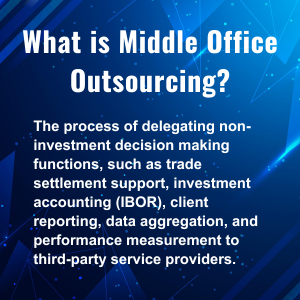 While the original driver of Middle Office outsourcing historically has been cost, over the past decade there have been many other drivers adding significant influence on the decision to outsource, including the impact of the pandemic and growing remote work environments, a tightened labor market, new technologies within the financial operations space offered by FinTech’s, and the constant impact of regulatory change and complexity in the securities markets. In fact, the Middle Office outsourcing market is projected to grow in the coming years. According to a report by Data Bridge Market Research, the global middle office market is valued at $6.27 billion and is expected to reach $14.05 billion by 2029, a CAGR of 10.60% during the forecast period of 2022-20291.
While the original driver of Middle Office outsourcing historically has been cost, over the past decade there have been many other drivers adding significant influence on the decision to outsource, including the impact of the pandemic and growing remote work environments, a tightened labor market, new technologies within the financial operations space offered by FinTech’s, and the constant impact of regulatory change and complexity in the securities markets. In fact, the Middle Office outsourcing market is projected to grow in the coming years. According to a report by Data Bridge Market Research, the global middle office market is valued at $6.27 billion and is expected to reach $14.05 billion by 2029, a CAGR of 10.60% during the forecast period of 2022-20291.
The future of Middle Office outsourcing is likely to continue to grow as financial institutions seek to increase efficiency, reduce costs, and stay competitive. However, there may be some changes in the types of outsourcing solutions and the level of outsourcing that institutions opt for. For example, there is a move towards selective outsourcing, where specific functions or tasks are outsourced rather than entire operations. There may also be an increased focus on strategic partnerships with outsourcing providers rather than purely transactional relationships.
Additionally, advancements in technology, such as automation and artificial intelligence, may change the nature of outsourcing, as well as the skills and qualifications required for Middle Office staff.
Innovative technologies are driving significant changes in the Middle Office outsourcing market. Some of the most important technological innovations in Middle Office outsourcing solutions include:
- Cloud-based solutions: Cloud-based solutions are becoming increasingly popular for Middle Office outsourcing. These solutions provide a scalable, flexible, and cost-effective platform for delivering these services.
- Robotic Process Automation (RPA): RPA is a technology that uses software robots to automate repetitive tasks. RPA is being used in Middle Office outsourcing to improve efficiency, reduce errors, and lower costs.
- Artificial Intelligence (AI): AI is being used in Middle Office outsourcing to analyze large volumes of data, identify patterns, and make predictions. AI is being used to improve risk management, compliance, and decision-making.
- Blockchain technology: Blockchain technology is being used in Middle Office outsourcing to provide secure, transparent, and auditable records of transactions. Blockchain technology is being used to improve the efficiency and accuracy of processes such as trade settlement and reconciliation.
- Big Data Analytics: Big Data Analytics is being used in Middle Office outsourcing to provide insights into business operations and risks. Big Data Analytics is being used to improve decision-making, risk management, and regulatory compliance.
These technological innovations are transforming Middle Office outsourcing solutions and providing financial institutions with new opportunities to improve efficiency, reduce costs, and enhance their competitive position.
Overall, the future of the Middle Office outsourcing market is likely to be shaped by a combination of economic, technological, and regulatory factors, as well as changing industry trends and best practices.
¹https://www.databridgemarketresearch.com/reports/global-middle-office-outsourcing-market
17009392 6/16/2023
 What is Middle Office outsourcing? Whether you are an investment or asset manager, wrestling with middle office functions is not a top priority but a necessary part of your business model. Or is it? Middle office outsourcing may be a viable alternative. It’s a business strategy that organizations use to streamline their investment operations.
What is Middle Office outsourcing? Whether you are an investment or asset manager, wrestling with middle office functions is not a top priority but a necessary part of your business model. Or is it? Middle office outsourcing may be a viable alternative. It’s a business strategy that organizations use to streamline their investment operations. While the original driver of Middle Office outsourcing historically has been cost, over the past decade there have been many other drivers adding significant influence on the decision to outsource, including the impact of the pandemic and growing remote work environments, a tightened labor market, new technologies within the financial operations space offered by FinTech’s, and the constant impact of regulatory change and complexity in the securities markets. In fact, the Middle Office outsourcing market is projected to grow in the coming years. According to a report by Data Bridge Market Research, the global middle office market is valued at $6.27 billion and is expected to reach $14.05 billion by 2029, a CAGR of 10.60% during the forecast period of 2022-20291.
While the original driver of Middle Office outsourcing historically has been cost, over the past decade there have been many other drivers adding significant influence on the decision to outsource, including the impact of the pandemic and growing remote work environments, a tightened labor market, new technologies within the financial operations space offered by FinTech’s, and the constant impact of regulatory change and complexity in the securities markets. In fact, the Middle Office outsourcing market is projected to grow in the coming years. According to a report by Data Bridge Market Research, the global middle office market is valued at $6.27 billion and is expected to reach $14.05 billion by 2029, a CAGR of 10.60% during the forecast period of 2022-20291.

